How to build a chicken nest. Nest sizes and perches for laying hens
It would seem that the process of breeding domestic chickens in a private household does not require much effort from the poultry breeder. However, to get really high results, the productivity of chickens, it is recommended to study all the necessary nuances. Particular attention is paid to the arrangement of the chicken coop for birds from the inside. Where to put nests for laying hens, how and what sizes to equip feeders and drinkers (they are not just necessary, but mandatory). All this requires a serious approach.
Types and benefits
It is not difficult to build nests for laying hens with your own hands, if you understand the basic principle. But before equipping nests for domestic chickens, it is recommended to find out which types of them are distinguished and which of them are most often preferred by domestic farmers.
There are several types of chicken nests:
- in the form of boxes. What does this kind of egg storage look like? This is a small wooden house with an opening at the top. What is remarkable about this design is the ability to provide comfortable conditions for a laying hen. In a cozy shaded room, she will be able to rush much more intensively, since any laying hen prefers a calm atmosphere and the absence of bright lighting. Another advantage of this do-it-yourself chicken nest is their practicality. In addition, young hens can be taught to it without much effort. To do this, they are placed in the device and the structure is briefly closed;
- from improvised materials. Let's say you spontaneously decided to start breeding domestic chickens in the courtyard, or you prefer to devote time to this only in the summer. In this case, the construction can be carried out randomly and with the help of improvised components. This option will be quite optimal for farmers who do not contain a large number of poultry in the chicken coop. What is used as a substitute? You can get by with cardboard boxes, baskets, boxes. Chickens quickly get used to their home. Fulfill one key condition - all DIY alternative chicken nests must be intact and clean. In this case, the birds will not even be able to notice the difference;
- with egg box. The dimensions of this type may vary, depending on the technology you use for their manufacture or the use of certain materials. However, the essence of such a device is that the laying hen could not make much contact with the egg (for example, some chickens peck their eggs). That is, farmers attach special pallets or some kind of containers along which the eggs will roll down. A nest for hens with an egg collector is considered the best option for any farmer.
It is up to you to decide which type of chicken nests to give preference to. It all depends on the characteristics of growing poultry in a particular area, and also solely on your intentions.
Video "The advantages of perches for chickens with an egg collector"
From the video you will learn why you need such a nest with an egg collector.
Size Requirements
What should be the size of a chicken nest? First of all, pay attention to the species features of the poultry breed you breed in the courtyard. Some layers will not need much space. But there are also representatives of larger varieties of chickens, over providing a spacious "living space" for which you will need to try. Remember, if a do-it-yourself nest for laying hens is not convenient, she will not be able to actively lay eggs in it. 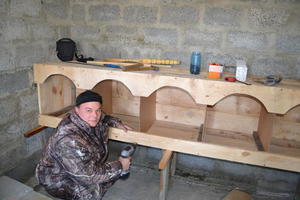
Another important point - in the chicken coop it is recommended to have a roof at an angle of 45 degrees. This is necessary so that the poultry do not get used to sitting on top of the house. As for the right time to install new chicken nests, such nuances should be considered even at the stage of building a chicken coop. Thus, the birds will get used to the conditions that are foreign to them much faster.
Placement rules
You can make nests for laying hens with your own hands without unnecessary difficulties, but the process of arranging a quality chicken coop does not end there. After that, it is advisable to think carefully about where to place nests for laying hens with an egg collector. Any nest for a chicken is placed in accordance with the physiological needs of poultry. 
- it is desirable to place it at a height of at least 30 cm;
- in order for the chicken to quickly get used to her new home, it is advisable to consider the presence of flooring in a box or box. For this, poultry farmers mostly use straw or sawdust;
- it is very important that the floor is constructed from a fine mesh. In the absence of such a base, it is advisable to make small ventilation holes in the floor;
- if we consider in more detail the optimal zones for the location of nests in the chicken coop, these include quiet secluded corners where bright light does not enter;
- It is not recommended to mount homemade chicken nests directly on the wall. Firstly, in this position, the structure you built is unlikely to last long, and secondly, in winter, the boxes will always remain cold.
Knowing how to make a nest for laying hens, and how to place it in the coop correctly, you can follow all the recommendations of experts.
Manufacturing instructions
How to make nests with an egg collector? First you need to make a plan construction works and prepare drawings. After that, it will be possible to purchase materials and proceed to the implementation of your idea. 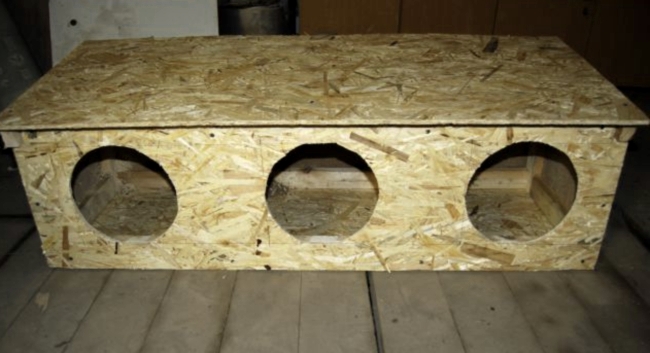
It is not worth inviting specialists to work, since you can do all this yourself. The main thing is to get the tools and follow the drawings.
Construction in the form of boxes
How to make nests for chickens using ordinary boxes for this? In the course of construction work, you will need plywood, timber, fasteners, sandpaper, an electric jigsaw, a screwdriver, and a hammer. Nest size for laying hens will vary depending on the size of the poultry. Such a construction solution will cost you much less than buying special nests in a store.
Egg box design
How and what size to build a nest with an egg collector with your own hands? 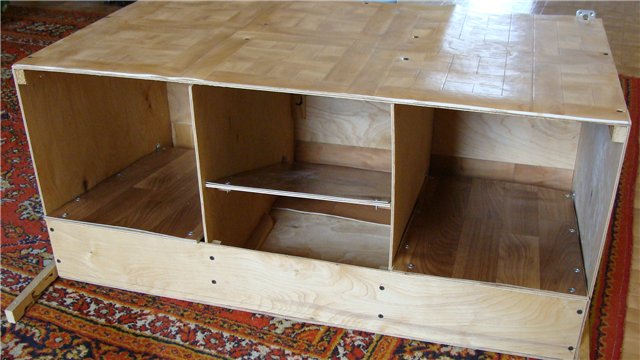
In general, the design appearance somewhat reminiscent of cardboard boxes or boxes converted into chicken "houses", with the exception of one important feature: the bottom in this instance should have a slight slope.
This way the eggs will roll into the tray and you can pick them up without disturbing the hen. Essentially, you need to construct a device with a double bottom. This is not so easy to do, but the result will certainly satisfy you. It is also recommended to give preference to this type of nest so that chicken eggs do not peck. Remember, chicken nests made according to the rules can greatly increase the productive characteristics of poultry. Therefore, if you want your chickens to rush intensively in the nests, and the devices themselves turn out to be durable and strong, build them thoroughly and with high quality.
Experienced poultry farmers know that a properly equipped poultry house can significantly improve egg production and egg quality. The presence of nests, or special places for laying hens, is convenient not only for them, but also for the owner of birds - he will not have to look for eggs in the corners or in other hard-to-reach places, and will also protect the “harvest” from being eaten by other birds. How to get an item so necessary for a chicken coop? Today, nests can be purchased at agricultural stores, but if desired, any poultry farmer can build them on their own.
The nest is a small container (box, box or basket) with lined bedding, straw or sawdust. But in fact, not everything is so simple, because in order for the chickens to rush well, the nests must meet a number of requirements.
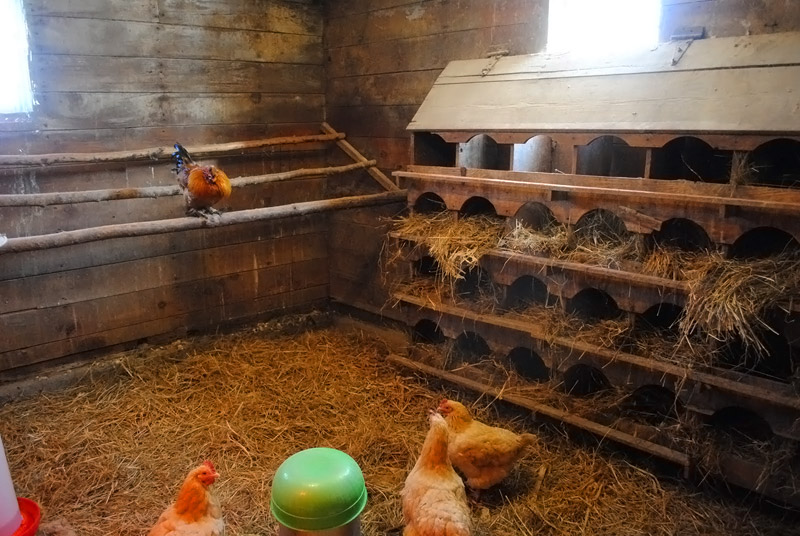
Before building nests, it is necessary to carefully plan their placement so that it is convenient for the hens to lay eggs, otherwise they will rush in their usual places, and it will be impossible to accustom the hens to a new home.
Types of nests and their features
There are several types of nests, each of which has its own characteristics, advantages and disadvantages.
| Type of nest | Peculiarities | Advantages |
|---|---|---|
| It is a regular box with an opening, inside which laying hens can lay their eggs. | It is very easy to accustom chickens to such a nest - just close them inside for a few nights. | |
| For the manufacture of structures, any containers (boxes, buckets, baskets) can be used, the main condition is that they must be clean and intact. | The main advantage of nests is low cost | |
| A special design, which implies a special container into which the eggs are rolled - this greatly facilitates their collection | To make such a design is much more difficult than the rest; if serious mistakes are made during the construction of the nest, the eggs will break |
When building nests, it is important to take into account the breed of birds: for ordinary laying hens, small nests (25x35x35 cm) are suitable, and for meat and egg crosses, structures of at least 30x40x45 are required.
Video - Nest trap for laying hens
Step by step instructions for building nests for laying hens
Nest from improvised materials
If it is necessary to equip a chicken coop as soon as possible, “houses” for laying hens can be put together from any materials at hand: boxes, boxes, buckets or any other containers (some poultry farmers even use cut tires and old furniture with compartments or shelves). The main condition that is put forward for the choice of containers is that they must be spacious enough so that the laying hens are comfortable, and the surfaces must not have defects, chips or signs of rot. The containers are installed in the chicken coop, filled with sawdust or hay and covered with curtains. Typically, such structures are temporary and are operated until permanent and stronger ones are made.
regular nest
Arranging the most common nest from boards, plywood or OSB boards does not require special knowledge, a lot of time or labor. Structures can be both separate and multi-tiered - in the second case, a small ladder should be brought to each tier. In addition to lumber, the following materials and tools will be needed to build the structure:
- fasteners (nails, screws, self-tapping screws);
- sandpaper or file;
- timber;
- screwdriver;
- a hammer;
- saw (manual or electric).
Important: to build nests, you can not use fasteners whose length exceeds the thickness of the lumber, as its ends can injure laying hens.
Step 2. Work the lumber well with sandpaper and a file to eliminate all sharp corners and roughness.
Step 3. Cut out the details of the structure, if necessary, process them again.
Step 4. Fasten the parts together, and in order to give the resulting box rigidity, fix the beam from the inner corners.
Step 5. Provide an entrance to the nest: you can simply leave the front side open, or board it up and cut a small hole. At the bottom of the structures there should be a small threshold about 10 cm high.
Step 6. Step back from the entrance to the box 10 cm, and then fix a horizontal rail there, which will serve as a take-off platform for birds.
After making nests, they should be carefully checked for sharp corners, protruding nail ends, or roughness.
The nest equipped with a container for collecting eggs is a special design that will greatly facilitate the collection of eggs by the owner, it can be equipped in two ways: with a double bottom or a special container.
In addition to lumber, fasteners and tools (listed above), to build such a nest you will need soft non-slip material for upholstery of the second bottom: it can be felt, linoleum, which is nailed with the wrong side up, or any soft fabric. The algorithm of work in this case is as follows.
Step 1. As a template for building a nest, you can take the previous design or an ordinary doghouse. A drawing should be made in advance, according to which the parts should be cut, after which it is good to clean them with a file and emery.
Step 2. The bottom of the nest must be attached at a slope of about 5 degrees relative to the back wall, and between its surface and the bottom there should be a gap into which the egg can easily pass.
Step 3. The main feature of such a nest is the presence of a pallet where the eggs will fall (it should be about 10 cm longer than the main structure). The pallet should be upholstered with the selected material and attached to the front of a small bar.
Step 4. Strengthen the tray in the same way as the bottom of the nest - at a slope of 5 degrees so that the egg laid by the chicken rolls along the bottom and falls into the tray.
A nest with an egg container is made in the same way, but instead of a gap between the back wall and the bottom, a hole should be cut in the lower part of the container, the diameter of which is slightly larger than the diameter of a chicken egg.
Video - Nest with egg collector
The frame structure is strong and durable, and for its construction you will need the same materials as for a conventional wooden nest. The algorithm for performing work in this case looks like this: first, a frame is knocked together from the bars, which is sheathed with plywood. The egg collector is optional.
metal socket
Making a nest out of iron will require a little more labor and expense than a wooden one, but it will last for many years. To perform the work, you will need the following tools and materials:
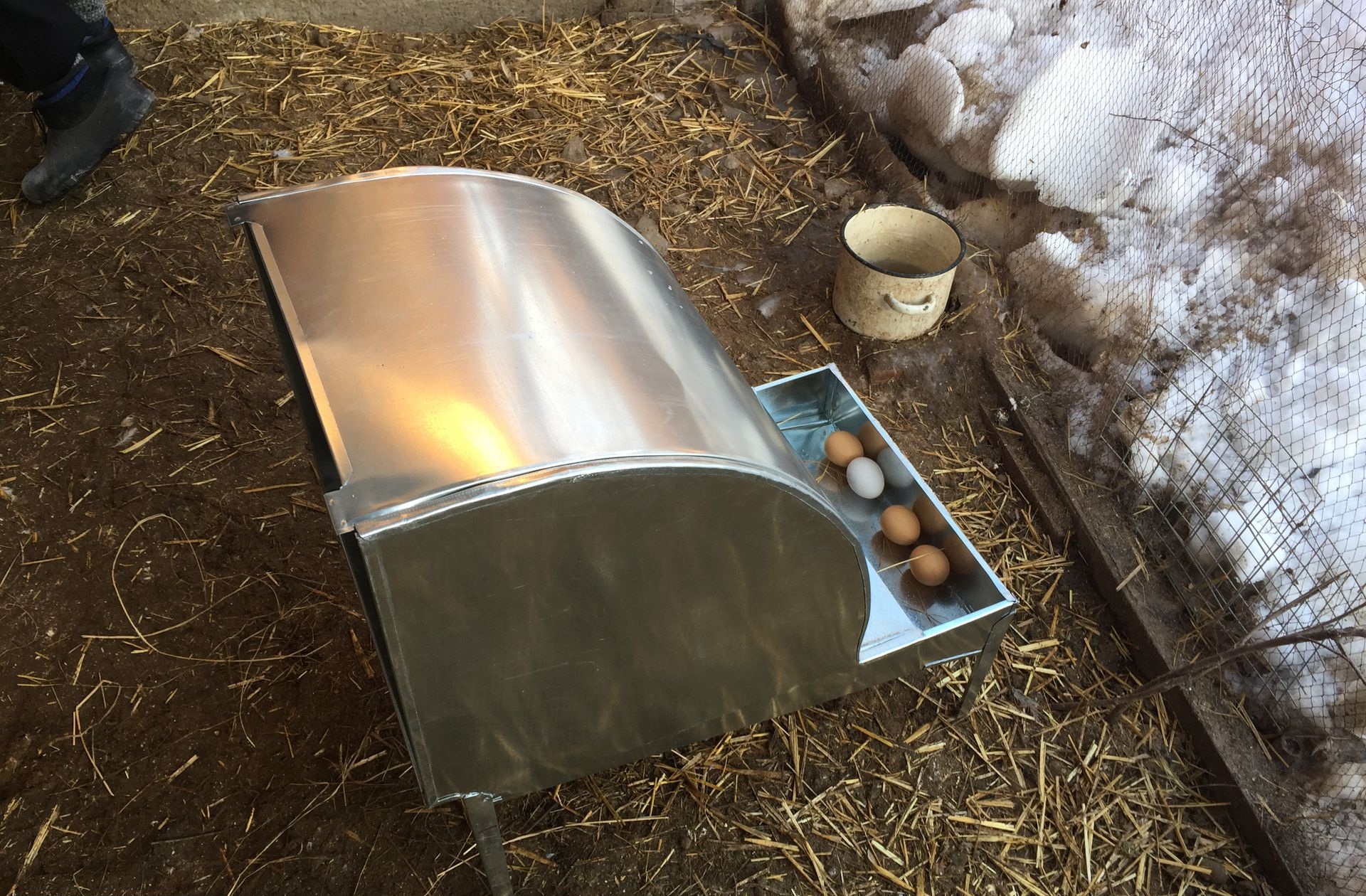
Step 1. Draw drawings, make markings on steel sheets, cut out structural elements.
Step 2. Cut the bottom of the nest from the mesh, the second option is the wire from which you need to weave the corresponding part.
Step 3 Fasten the parts in the following sequence: first the walls and the bottom (at an angle of 10 degrees), then fix the roof.
Step 4. A container for collecting eggs is installed in front, which is cut out of steel sheets and sheathed with soft material.
The peculiarity of this design is that it is designed for several chickens - from 2 to 5. The nest area can be any, but one laying hen should have at least 100 cm2. It must have an egg collector, a shelf for collecting litter, a drinking bowl and a feeder. For the manufacture of such a "dwelling" you will need the following materials and tools:
- sheets of tin;
- wooden blocks 4x4 cm or metal profile;
- metal grid;
- nails or rivets (if a profile is used to build the nest);
- hacksaw;
- a hammer;
- pliers;
- hecks for doors, if desired, wheels for legs;
- suitable sized feeders and drinkers.
If the corresponding feeders and drinkers were not found, they will need to be made in advance from sheets of tin. The order of work on the manufacture of a "family" nest is as follows.
Step 1. According to the drawn drawings, assemble the frame of the structure. For greater strength, you need to make additional stiffeners along the walls and the bottom, and if desired, the legs can be equipped with wheels, which will facilitate cleaning and moving the nest.
Step 2. Attach the bottom and tray exactly as described in the instructions for making nests with an egg collector - the bottom is at an angle of about 10 degrees, the tray is at the bottom.
Step 3. Partitions between cells are best made of mesh (the use of solid material is not recommended, as it does not provide sufficient ventilation). The mesh is fastened with rivets and pliers.
Step 4 Drinkers and feeders are attached to the front of the nests, after which doors are installed. They are made of mesh with large cells so that the inhabitants have unhindered access to food and water, after which they are equipped with hecks.
How to properly attach nests?
Nests must be attached so that it is convenient for chickens to get inside and lay eggs there, and it is desirable that the walls of the structures do not touch the walls of the house. There are several options for this, and one of them is on special stands that are attached to the walls of the house. Materials needed for work: boards (30x4x2) and screws.
Step 1. Consider the placement of nests in the room, and then attach a board to the wall, which will play the role of a base.
Step 2. Attach the second board with the same dimensions at an angle of 45 degrees, and the two planks should diverge at the bottom general design, and the distance between the edges of the boards should not exceed 40 cm.
Step 3. Step back 45 cm and build a similar structure, but the boards in it should converge at the top, not at the bottom.
Step 4. Attach the sockets with screws to the resulting compartment, check for strength.
Pour sawdust or hay into the bottom of the nests in a small layer (the filler layer should be 10 cm lower than the sides of the pallet). If the nests are equipped with an egg collector, you need to make sure that the filler does not prevent eggs from falling into the bottom.
How to accustom a laying hen to the nest?
Nest Care
Caring for homemade nests is quite simple - for this you need to perform a number of activities:
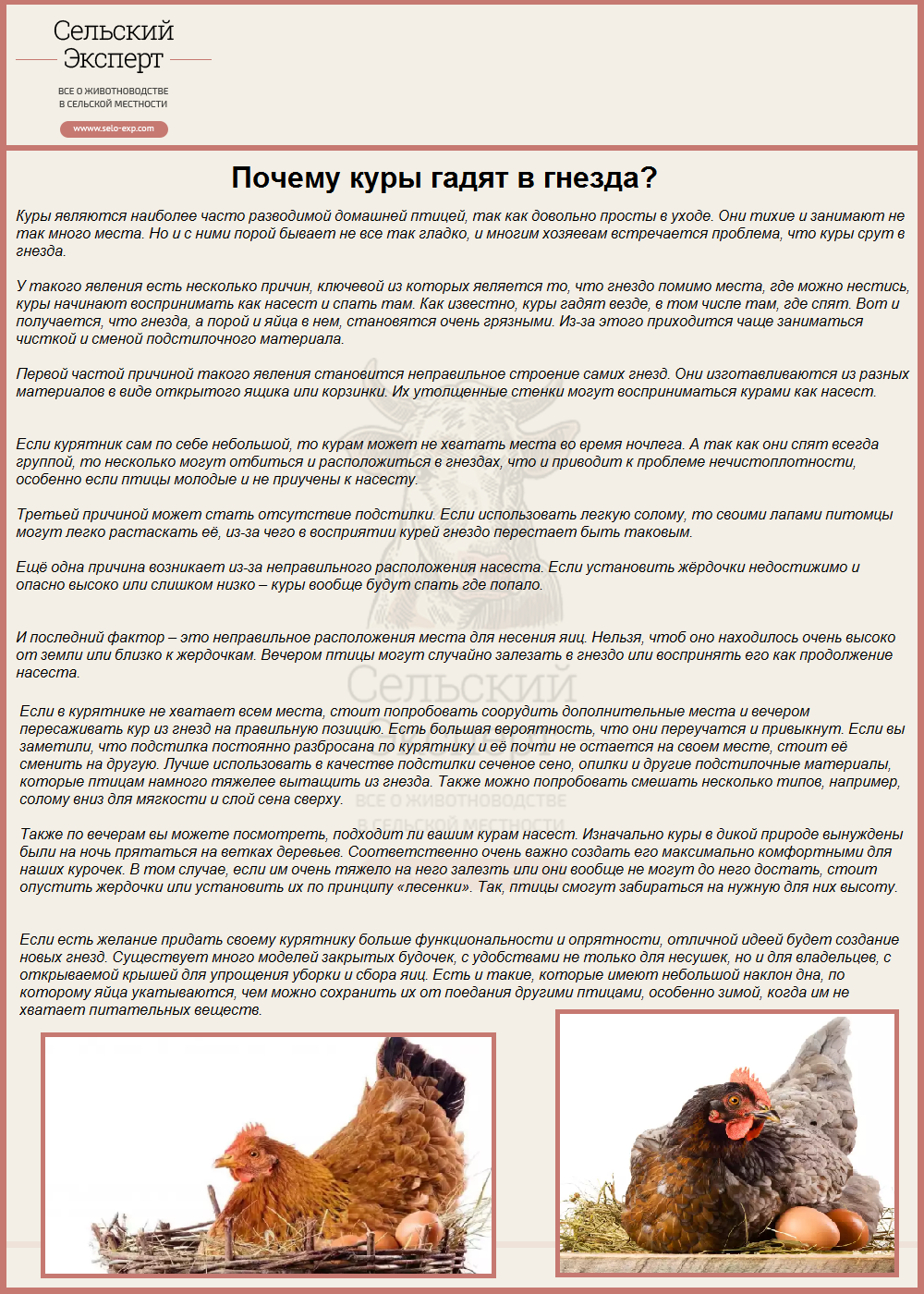
Finally, do not forget that if the hens do not want to rush in the nest, then there are serious errors in the design or location that need to be corrected.

To properly organize the space inside the chicken coop, you need to properly equip perches and nests. The perch is a crossbar made of a bar or a round blank on which the chicken sleeps. You can use different options for devices for perches.
Depending on the size of the coop and the number of birds do different types perches:
- It can be a crossbar around the perimeter indoors. This option is suitable for a small barn with a small number of chickens. The perch is fixed at a certain distance from the wall for the unimpeded location of birds for the night.
- Crossbars can be attached to different levels to accommodate a large number of birds in a small area. The distance between the perches is made at least 30 cm. In this case, the chickens will not stain each other with droppings.
- In a small farm, perches are built on vertical supports, which are pillars about a meter high. Crossbars are attached to them.
- Perches can be made in the form of portable structures. This allows not only to move them inside the chicken coop, but also more convenient to clean indoors.
- With a small number of chickens, you can make a box with a handle. She will serve as a perch. And in the box, install a grid for sifting litter into a container. If necessary, this box is taken out and cleaned.
- If the farm is larger, then perches can be made in the form of a table with crossbars. In this case, bars are vertically attached to the manufactured table, to which crossbars are attached to the screws. Pallets are placed on the surface of the table to collect litter.
How to make a perch
To make a perch need to know some parameters to comfortably accommodate the chickens:
- What should be the length of the crossbar for one bird.
- At what height to place the perch.
- Crossbar size.
- When equipping a multi-tiered structure - the distance between the levels.
It is better to place the perch near a warm wall, opposite a window where there are no drafts. The order of work for the construction of perches should be the following:
- At a certain height from the floor, depending on the breed of chickens, a bar with a section of 6 by 6 cm is nailed horizontally to the walls.
- The crossbars of the required diameter are hewn and processed from notches.
- Then, with the help of self-tapping screws, they are attached to the beam, at the recommended distance.
- Stepping back 30 cm from the floor, horizontal strips are stuffed. They have litter trays.
- To make it easier for chickens to climb a perch, you can make a ladder. It is better to install it as far as possible.
When the horizontal beam is located at an angle, a multi-tiered structure is made. In the same way, perches are built in the center or corner of the chicken coop.
Perches for laying hens are located higher than other birds, as they must have well-developed muscles. When climbing to a high perch, they are subjected to physical stress - this is effective method to keep them active. To give each chicken enough space - they won't push each other out.
Nests for chickens
 In order for birds to lay their eggs in a certain place, it is necessary to make nests. For this you can use ready-made containers. It is enough to cover them with hay or sawdust and the nest will be ready.
In order for birds to lay their eggs in a certain place, it is necessary to make nests. For this you can use ready-made containers. It is enough to cover them with hay or sawdust and the nest will be ready.
For containers, you can use cardboard boxes, wooden or plastic boxes, wicker baskets. Before using such a container, you need to check it for integrity. Do not allow nails to stick out or sharp splinters. They can hurt the chicken or damage the egg.
When using ready-made containers, it is necessary to adhere to certain sizes of future nests. For breeds of chickens of medium size containers must be 30 cm high and the same width and length. Nests are placed in a dark and quiet corner of the house. This is necessary so that the chickens are calm. The nests are located on an elevation from the floor so that there are no drafts. They make a ladder to them, and in front of the entrance there is a perch, on which the chicken can rest and get inside without difficulty.
Making nests for chickens from OSB board
Make a chicken nest you can do it yourself. For this you will need:
- OSB board (oriented strand board), the thickness of which is 8-10 mm.
- Screwdriver.
- Electric jigsaw and a nail file for wood.
- Screws.
- Wooden blocks with a side of 25 mm.
Work order
- First of all, you need a jigsaw from OSB boards cut the sides of the nests into a rectangular shape 15 by 40 cm. 4 rectangles are needed for each nest. You need to cut them so that the edges do not break. To do this, you need to increase the speed on the tool, and move slowly along the canvas.
- Then cut wooden blocks 15 cm long (this is the height of the nest). Having installed them at the corners of the box, screw the cut rectangular plates to them with self-tapping screws.
- The bottom is also cut out of OSB with a square with a side of 40 cm. Screw this sheet to the corners of the box.
- Having made a nest, it is necessary to fill it with hay, straw or sawdust to 1/3 of the volume. Ready-made nests are mounted on walls or installed on special scaffolds.
Laying hen nest
Nests for chickens do it with an egg tray- this is a good option for those who do not have time to regularly check the boxes for the contents of the eggs. To make such a nest, you need a little time and the necessary material. The peculiarity of this design is that the bottom has a slight slope. On it, the eggs roll into the substituted tray.
If you decide to breed chickens in your backyard or in the country, you will have to carefully consider all the nuances so that the bird rushes well. In order to do this, you will need not only to equip a chicken coop and a place for walking, but also make nests for laying hens so that eggs do not peck.
How to make nests for laying hens with your own hands
In terms of choosing a place for laying eggs, chickens are very picky creatures, they can ignore a convenient nest in your opinion and start rushing in a completely inappropriate place for this. Therefore, before you equip a nest for laying eggs, watch the birds: what places they prefer, how many hens sit in the same nest, at what time.
Photo of a nest for laying hens from improvised materials
In order to choose desired design nests for laying hens with your own hands, you must proceed from the number of chickens in your household. For a few farms, simple designs and drawings are suitable, and for large farms, more spacious and complex ones.

Drawing with the dimensions of the nest for laying hens
The most elementary option is the most ordinary wooden box of a suitable size, in your opinion, for arranging the nest of laying hens so that eggs do not peck. At the bottom you need to lay straw or hay, and you're done!

Photo ideas nest for laying hen
Another option is to put together a box yourself from plywood or board, sawing it into 3 identical parts. Next, install the bottom, fill it with dry material. General rule for all types of nests: they should be installed at a height of about half a meter from the floor.

Photo of nests in a chicken coop so that chickens do not peck eggs
The final step is to install a ladder to the nest so that the bird can get into it. It is better if it is a wide board with crossbars nailed to it. The dimensions of such a box can be something like this: depth - about 40 cm, width - at least 35 cm. These dimensions are observed for all types of boxes.
How to make a nest for a laying hen with an egg box
It happens that it is impossible to visit your pets regularly, and it becomes necessary to save the eggs until the next visit. In this case, it is recommended to build a nest with an egg collector. Its essence is that chicken eggs roll into a special tray at the bottom of the box and accumulate there.

Photo of a nest with an egg collector
The process of making a box with a pallet is quite simple: first knock down a simple box, as mentioned earlier, cut a hole for the egg in the bottom, and install the second retractable bottom not evenly, but with an inclination of 8-10 degrees. And, as usual, line the bottom with bedding.
Such a nest with an egg collector for laying hens can be improved by making several sections or tiers in it. The angle of inclination of the bottom in such a box is not 10, but about 40 degrees. Making it a little more difficult than the previous one, but quite capable. The nest should be higher from the floor than usual - at a distance of at least half a meter. A kind of “corridor” must be built along the entire length of such a box so that chickens can enter free sections. Such boxes are installed in such chicken coops, where there are many laying hens.

Laying hen nest idea
You can also make a house that looks like a dog house - completely enclosed with a hole cut in the front wall, enough for a chicken to crawl into it. For comfort, add straw to the nest - and you're done.
For craftsmen there is interesting option- frame nest according to individual sizes. To make it, you need to put together 2 frames for attaching wooden bars about 40 cm in size to them. The frames must be fastened together with bars in such a way that a square or rectangle is formed. Next, install the walls of the nest for laying hens, a suitable bottom (flat or sloping), fill with hay or straw. This design is highly durable.

Nest sizes for chickens so that eggs do not peck
As can be seen from all of the above, special skill and skills are not required to build a chicken nest. Materials can be used at hand, tools - a hammer and nails - can be found in every household. The point is small - to find an acceptable solution and bring the idea to life!
DIY nests for laying hens can be made from the photo, knowing the dimensions. Experiment, then your chickens will not peck eggs and will please you with high egg production. When farming and raising poultry at home, observation and resourcefulness are important.
Those people who live in private houses are mainly engaged in breeding animals and birds. As a rule, chickens are bred more often. It is easy to care for him, and as a result, he eats his eggs and meat. In order for the eggs to always be clean, and the chickens to lay in one place, it is necessary to equip the chicken coop with nests. It's easy to do.
Highly just make nests for laying hens in the form of a box with their own hands. For this you will need the following materials:
- Board or plywood;
- Nails;
- A hammer;
- Hacksaw.
How to make a nest for laying hens:
- Cut the prepared board (plywood) into equal parts.
- Using a hammer and nails, connect the resulting elements so that you get a box.
- Straw should be laid in the box made and installed thirty centimeters from the floor.
- To the box, if desired, you can attach a small ladder. So, it will be easier for chickens to get into the nest.
Laying hen nest dimensions
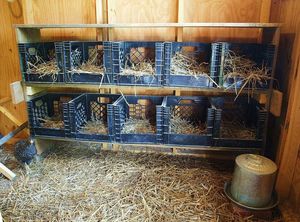 chicken nest must fit the following dimensions: the depth of the nest should be more than forty centimeters. Height and width thirty centimeters.
chicken nest must fit the following dimensions: the depth of the nest should be more than forty centimeters. Height and width thirty centimeters.
The resulting design must be installed in a dark and warm place in the chicken coop. The size of the nest should fit the hen, and it should also be comfortable. If the chicken does not want to rush in it, then she does not like it and should be redone.
Where and how to install nests
For the hen to lay in the nest you made for her, you need to know a few rules:
- It is better to install such structures in a dark place and away from drafts.
- For bedding the best option is straw or sawdust;
- The bottom is better to do from the grid. This is necessary for ventilation.
- It is necessary to hang the house at a distance of at least thirty centimeters from the floor, and you also need to take into account that you should not nail it to the wall.
- It is not worth installing the structure in wet places. This can lead to illness in chickens.
- Access to eggs and bedding should be convenient.
Nests for laying hens with an egg collector (drawing)
Often the owner of his birds, due to various circumstances, cannot regularly visit the chicken coop and collect eggs. In this case you need egg box design which you can make yourself. This nest is also called a "double bottom nest". Such a device becomes recent times more and more popular. It differs only in that its bottom has a slope. Thanks to the slope, the eggs roll to the right place.
In order to make such a device, you will need:
- Make a regular box out of plywood or boards.
- The bottom should have a slope of approximately ten degrees.
- Make a hole in the tray and attach the tray.
- Lay straw or sawdust.
There is another option for making such a nest for laying hens with your own hands.
In this embodiment, the angle of the bottom should be forty degrees. The design may contain three or four tiers. There are no big differences in size. But you only need to take into account that this design is not installed thirty centimeters from the floor, but fifty centimeters. At the bottom of the box you need to make a hole where the testicles will roll. To keep them from breaking tray needs to be installed.
You can make such a chicken nest with an egg collector according to this drawing.
For this you will need:

Manufacturing instructions:
- Pre-treat the prepared material (boards or plywood) with sandpaper.
- We cut plywood or boards to certain sizes.
- The resulting elements are knocked down with nails and a hammer. Should be a box. For greater strength, attach the timber from the inside at the corners.
- Make the front the way you want. It can be open or made of plywood with a hole.
- On the bottom of the resulting box, you need to nail the bar.
- Now we attach the bar horizontally, ten centimeters from the hole (entrance). She will help the chicken to get inside.
- At the bottom of the box you need to make a hole about ten centimeters.
- To the bottom you need to attach a pallet with an inclination to the back wall. At the bottom of the back wall, make a hole into which the testicle will roll.
- We attach an egg collector behind the back wall, it must be upholstered with a soft cloth so that the testicle remains intact when it falls.
- In the floor of each cell we make a hole with a diameter of ten centimeters.
- Lay straw or sawdust on the bottom.
- Attach the resulting design in the chicken coop.
Unusual nests for laying hens do it yourself
These laying nests are very looks like a dog kennel.
To make a nest you will need:

First you need to make a box of plywood or board according to the same principle as described above. The dimensions of the box will be the same, but there is only one difference - the box must be without front wall. From the remaining plywood, you need to draw, and then cut a hole. It should be wide enough for the chicken to fit in freely. This will be the front wall of the structure. Well, that's it. Now it remains only to lay straw or sawdust in the nest.
Do-it-yourself frame model (drawing)
To make it, you will need materials such as:
- timber;
- Nails;
- Plywood or boards;
- Sandpaper;
- A hammer;
- Plank, ten centimeters wide;
- Hand saw;
- A simple pencil and a special ruler.
Such a model can be made in the form of separate cells, as well as in the form of sections.
Manufacturing steps:
- Prepared plywood or boards need to be processed with sandpaper.
- Cut the material, taking into account that the width and height of the workpiece should not be less than thirty centimeters. If you decide to make the model in the form of sections, then in order to calculate the length, you need to multiply the number of sections by thirty.
- From the resulting segments you need to put together a box. In the corners, do not forget to nail the timber (on the inside). This is necessary in order for the box to be more durable.
- The front part can be both open and in the form of holes. It depends on your desire.
- Now we need to make a threshold. At the bottom of the box, nail the prepared bar.
- If you decide to make the model multi-tiered, then for each tier you will need to make a ladder.
- It remains to lay the existing bedding and you can hang the structure in the intended place.
Very simple and fast nest
If it turned out that you simply do not have time to make nests from a special material, then you can make from ordinary boxes. How much and what material is needed? To do this, you need any box in which the chicken will fit freely. In this box it is necessary to lay sawdust or straw. Well, that's all, the place for laying eggs is ready!



